Food transportation facts: What fleets need to know about food miles, safety, efficiency and sustain
Understanding key food transportation facts is crucial for fleets to understand how miles traveled, transport modes and logistics decisions directly impact food safety, costs and sustainability.
By Geotab Team
Oct 2, 2025
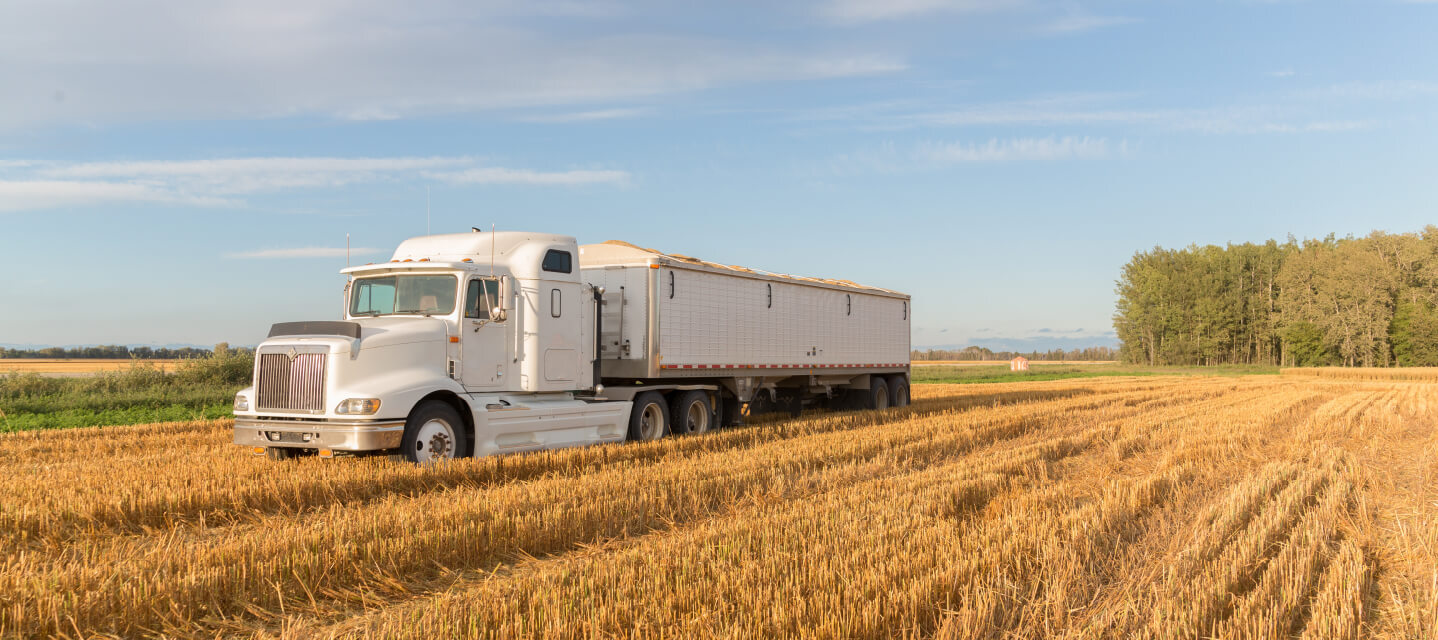
Key Insights
- Food transportation facts show that U.S. food travels 1,300-1,500 miles on average before reaching consumers, making transportation a major factor in sustainability and supply chain efficiency.
- Air freight produces the highest emissions per ton-km, followed by road, with rail offering the lowest.
- Food transportation matters for fleets because effective cold chain logistics reduce spoilage, ensure safety compliance and increase profitability.
- Leveraging technology like telematics, route optimization and real-time monitoring helps fleets cut costs, lower emissions and deliver fresher food quicker.
Between 2020 and 2025, domestic trucking for food transportation increased 8%, highlighting the increasingly important role of effective cold chain logistics to ensure food safety, maintain compliance and increase route efficiency to improve profits.
Understanding food transportation facts is essential for fleets that move fresh produce, dairy, meat and packaged foods. Fleets can leverage these insights to ensure food safety, maintain regulatory compliance, reduce spoilage and optimize routes for greater efficiency and profitability — all critical to staying competitive in today’s food supply chain.
What are food miles?
Food miles describe how far food travels from the point of production to the consumer’s plate. The concept is used to estimate the environmental impact of transportation, since longer journeys generally use more fuel and produce higher carbon emissions.
In the United States, food travels an average of 1,300 to 1,500 miles before reaching consumers, though the distance varies by product and season. Not all miles have the same impact, as transport mode and efficiency play major roles.
Another key factor is last-mile delivery, the final stage from the distribution hub to a store or home. Despite short distances, it can generate high emissions due to smaller, less efficient vehicles. Considering both total food miles and last-mile delivery provides a clearer picture of food’s environmental footprint and helps consumers make more sustainable choices.
Why is food transportation important?
Agricultural transportation is the process of moving raw produce from farms to processing facilities, distribution centers and ultimately retail locations.
Efficient food transportation gives consumers access to a wide variety of foods, including fresh fruits and vegetables, dairy products, meat and dry goods that may not grow locally, increasing the food supply, particularly in food deserts, areas where residents have limited access to affordable and nutritious food.
Farm transportation is the first stage of this process, moving crops, livestock and other raw products from farms to processing or storage facilities. From there, foods are transported using different modes:
- Road (trucks) for flexibility and shorter distances
- Rail for large volumes over land
- Sea for long-distance bulk shipments
- Air for perishable or high-value items that require speed
Careful trucking logistics and coordination across these modes ensure food reaches stores and consumers efficiently, safely and sustainably, expanding access to diverse food options nationwide.
19 essential food transportation facts for fleets
Food transportation logistics are complex, and understanding key facts can help fleets manage cold chain monitoring more effectively. From maintaining product quality to reducing spoilage and ensuring compliance, these insights highlight opportunities to optimize routes, improve efficiency and protect perishable food throughout the supply chain.
General trucking food transportation facts
These figures highlight the critical role of trucking in moving perishable and high-value foods efficiently, emphasizing the importance of smart fleet management solutions to keep food safe, fresh and profitable across short or long distances.
1. In the United States, processed foods travel an average of about 1,300 miles, and fresh foods travel around 1,500 miles before reaching consumers. (Leopold Center for Sustainable Agriculture)
2. The United States transports about 2.7 billion tons of food each year. (U.S. Department of Transportation)
3. Trucks carry the highest-value shipments under 2,000 miles, dominating short- and mid-range food transportation. (U.S. Department of Transportation)
4. In 2024, trucks transported more high-value, time-sensitive perishable foods than any other mode. (U.S. Department of Transportation)
5. In 2024, trucks handled 79% of all in-state shipments, making them the dominant mode for intrastate transportation. (U.S. Department of Transportation)
6. In 2024, 74% of all goods by weight were transported less than 250 miles. (U.S. Department of Transportation)
Environmental impact of food transportation facts
The movement of food has a significant environmental footprint, with emissions influenced by distance, transport mode and efficiency. Longer food miles generally produce more greenhouse gases, while trucks, rail, air and ships have very different carbon profiles.
By understanding these dynamics, fleets can make data-driven choices to reduce their impact through electrification, optimized routing and proactive vehicle maintenance.
7. The food industry is responsible for 10% of total fossil fuel consumption in the United States. (ATTRA)
8. Air transport generates more greenhouse gas emissions per ton of food than trucks or rail. (Future Foods)
9. In 2019, commercial trucks were responsible for 25% of all U.S. transportation emissions. (Congressional Budget Office)
10. Optimizing routes and reducing idle time can cut fuel costs and emissions by up to 20%. (Geotab)
11. Switching to electric trucks globally could reduce nearly 2 gigatons of CO₂ emissions by 2035, even after accounting for electricity generation. (IEA)
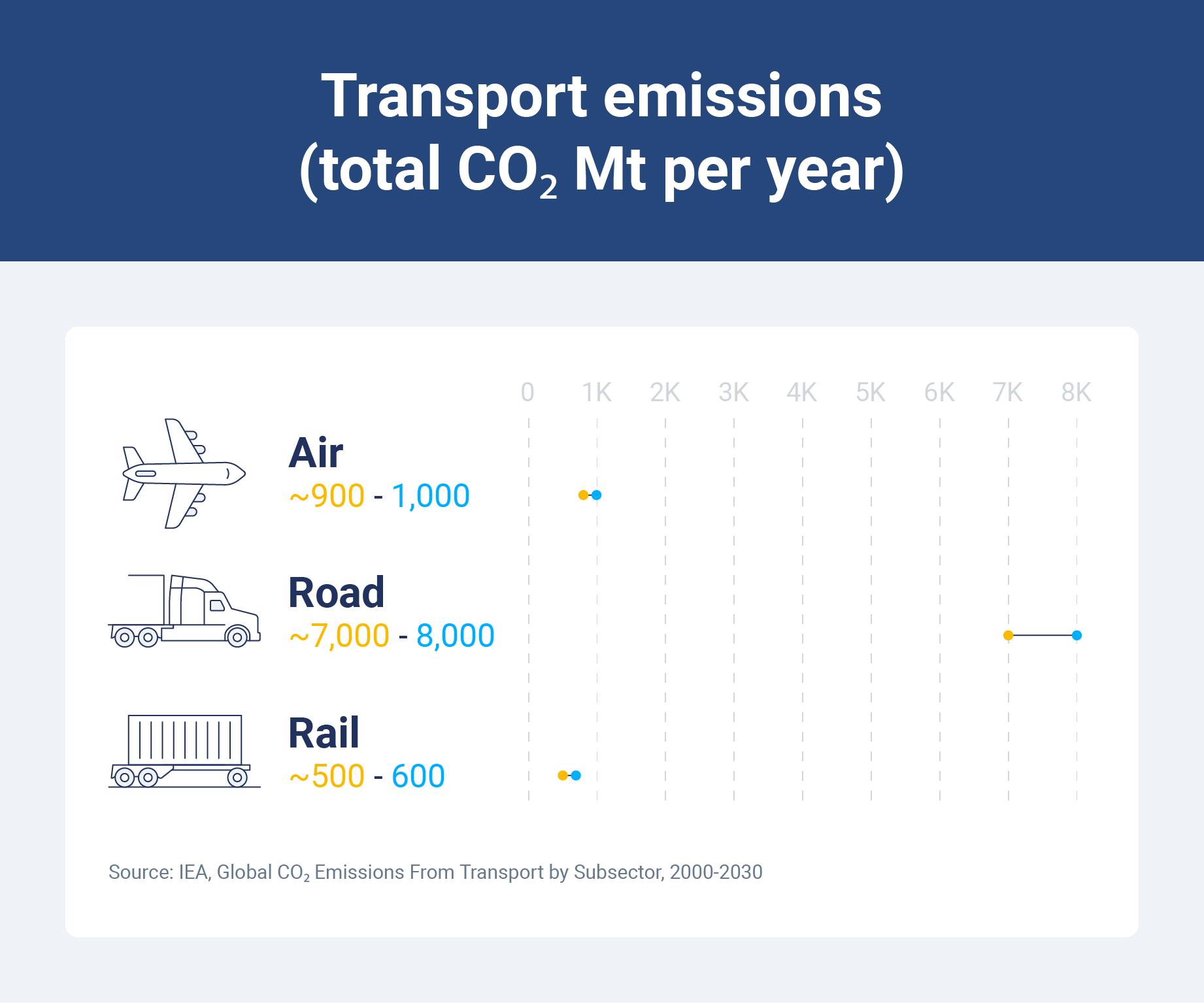
Food transport safety and regulation facts
Ensuring food safety during transportation is critical for protecting public health and maintaining regulatory compliance. The FDA’s Sanitary Transportation of Human and Animal Food (STF) Rule sets standards for temperature control, vehicle sanitation and record-keeping.
Fleet managers must also follow state and federal guidelines to prevent contamination and maintain the integrity of perishable foods throughout the supply chain.
12. Temperature-controlled foods must be kept within safe ranges during transport: 40°F (4°C) or below for cold foods, 0°F (-18°C) or below for frozen foods and 135°F (57°C) or above for hot foods to prevent spoilage and contamination. (FDA)
13. Fleet drivers must receive training on safe food handling and transportation practices under federal guidelines. (FDA)
14. Proper sanitation of vehicles and equipment is mandatory to reduce the risk of cross-contamination. (FDA)
15. Accurate documentation of delivery times, temperature and handling procedures is required to ensure compliance and traceability. (FDA)
Food waste and spoilage statistics
Food waste is a critical issue globally and in the U.S., affecting the economy, the environment and the efficiency of the food supply chain.
Significant losses occur at every stage, from farming to retail, highlighting the importance of better handling, storage and transportation practices to reduce waste and preserve valuable resources.
16. Around 2.5 billion tons of food are wasted globally each year. (RTS)
17. The U.S. wastes 60 million tons of food annually — nearly 40% of the national food supply and about 325 pounds per person. (RTS)
18. Food wasted in the U.S. is worth nearly $218 billion, equivalent to about 130 billion meals. (RTS)
19. About 30%-40% of food waste happens during the farming stage, before products even reach consumers. (RTS)
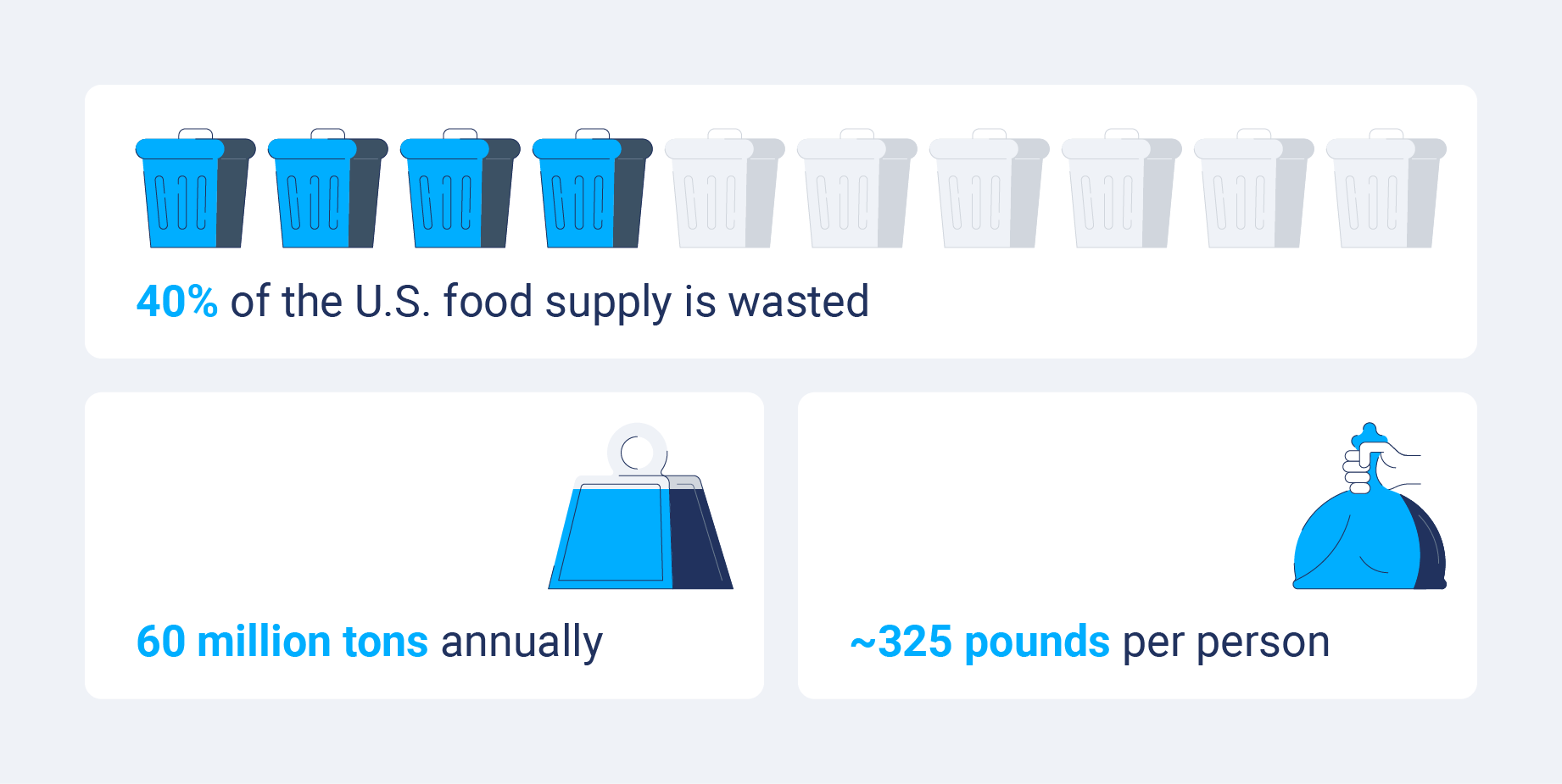
How fleet technology improves food transportation
Fleet technology is essential for modern food transportation, improving efficiency, visibility and sustainability across the supply chain. Telematics, GPS tracking, temperature sensors and electronic logging devices (ELDs) help food and beverage fleet management teams reduce unnecessary transportation time, helping perishable food arrive faster and fresher.
By using telematics to improve customer experience, fleets can deliver products that meet safety standards, reduce spoilage, lower the carbon footprint of food items and keep shelves stocked with the freshest options.
Integrating route optimization, real-time monitoring and compliance management supports every stage of agricultural transportation, from farm to last-mile delivery. End-to-end visibility helps fleets maintain cold chain integrity, respond quickly to disruptions and deliver high-quality food efficiently and reliably.
Optimize routes to cut travel time and spoilage
Transportation management system (TMS) software and route optimization tools help food and beverage fleets plan the most efficient delivery routes, shortening delivery windows and keeping food fresh.
By reducing unnecessary stops, idle time and backtracking, these tools ensure produce, dairy, meat and other perishable items maintain quality from farm to store. Optimized routes also lower fuel consumption and emissions, reducing the carbon footprint of food.
Learn more about routing and dispatching solutions
Track every mile with near real-time monitoring
Telematics, GPS fleet tracking and temperature sensors give real-time insights throughout every mile of transportation, helping maintain cold chain integrity for perishable goods like produce, dairy and meat.
In agricultural transportation, monitoring farm-to-distribution logistics helps raw products stay fresh while meeting safety standards and arriving on time.
Live monitoring also allows fleet managers to make on-the-fly adjustments to routes based on environmental factors like weather, traffic or construction. By responding quickly to these disruptions, fleets can prevent delays that would otherwise:
- Increase costs
- Extend delivery times
- Compromise food quality
Learn more about asset tracking solutions
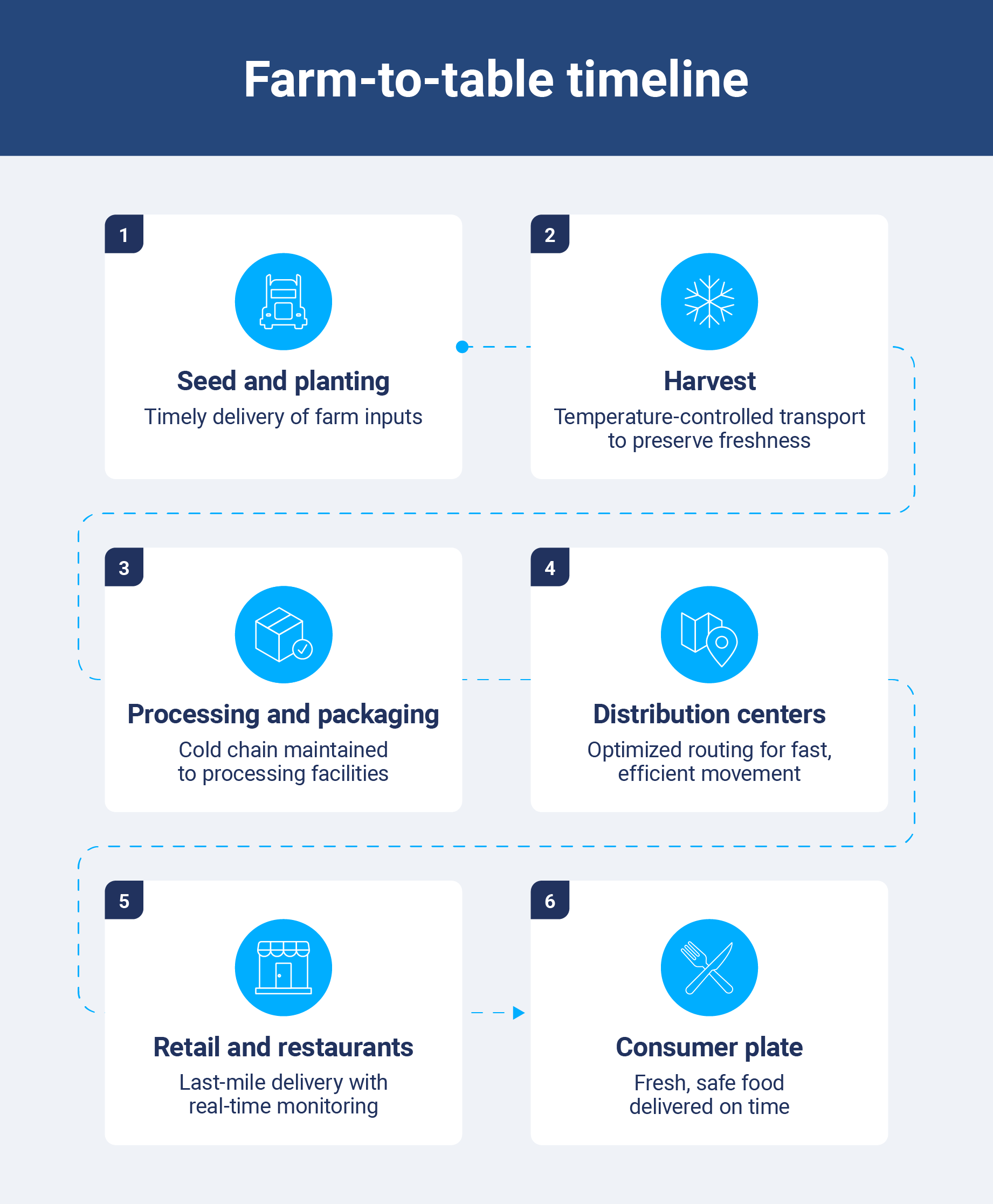
Maintain compliance with ELDs and food transport regulations
ELDs automatically track driver hours of service, providing fleets with accurate, real-time records of driving and rest periods. This improved tracking reduces the risk of regulatory violations and helps fleet managers plan shifts efficiently, making sure deliveries of perishable items stay on schedule.
Common challenges in transporting food
Food transportation presents unique obstacles that fleets must manage to ensure timely, safe and cost-effective delivery. Common food transportation issues include:
- Cold chain failure
- Regulatory compliance
- Delivery delays
- Fuel costs and inefficiencies
Addressing these challenges is essential for fleets to maintain smooth operations, protect perishable goods and deliver quality products to consumers.
Preventing cold chain failure
Cold chain failure can lead to significant product loss, compromised food safety and increased overhead costs. Constant temperature monitoring helps items remain within safe ranges throughout the supply chain.
Technology plays a key role in preventing these failures. Telematics, GPS and temperature sensors allow fleets to track environmental conditions in real time, sending alerts if temperatures deviate from set thresholds.
Best practices for cold chain management include:
- Using insulated containers
- Regularly maintaining refrigeration units
- Monitoring data integrations for proactive issue resolution
Staying compliant with food safety regulations
Fleets navigating Food Safety Modernization Act (FSMA) and Hazard Analysis and Critical Control Points (HACCP) requirements must ensure proper food safety practices across the supply chain.
- FSMA is a U.S. law designed to ensure the safety of the food supply by shifting the focus from responding to contamination to preventing it.
- HACCP is a systematic approach to identifying, evaluating and controlling food safety hazards at critical points in the production and transportation process.
In farm transportation, fleets prioritize food safety by integrating careful food handling and preventive sanitary measures into every stage of the supply chain. Fleet tracking tools help managers meet these requirements efficiently and address deviations quickly to keep deliveries on schedule.
Managing delivery delays and spoilage risks
Food transportation faces many potential delays, including traffic congestion, bad weather and road construction. In farm transportation, even short delays impact the timing of fresh produce deliveries to processing facilities, while long-haul shipments may encounter extended travel disruptions that impact multiple distribution points.
Delays can compromise freshness, setting off spoilage and operational disruptions that ultimately result in financial losses. By leveraging real-time tracking and route optimization, fleet managers can anticipate these delays and adjust routes to maintain reliable delivery schedules. This proactive planning protects perishable goods, keeping fleets operating sustainably and customers satisfied.
Controlling fuel costs and inefficiencies
Fuel costs and operational inefficiencies are major challenges in food transportation, especially for long-haul farm-to-market shipments. Poor route planning, excessive idling and underutilized vehicles can quickly drive up expenses and reduce overall fleet productivity.
Even small inefficiencies across multiple trips can result in significant financial and environmental impacts.
Technology and smart fleet management help address these issues. Route optimization tools, telematics and real-time monitoring enable managers to plan the most efficient routes, minimize idle time and maximize vehicle utilization, lowering costs while supporting timely delivery and sustainability.
Optimize every mile from farm to fleet
Keeping up with the latest food transportation facts is critical for fleets that move fresh produce, dairy, meat and packaged foods. From food miles and sustainability to cold chain safety and compliance, this knowledge helps food and beverage fleet managers make smarter decisions to protect quality and reduce waste.
With the right tools in place, fleets can turn these insights into action. Geotab helps food carriers strengthen cold chain logistics by tracking temperatures in real time and route optimization to keep food fresher for longer. By improving logistics at every stage, fleets can deliver food safely, sustainably and on time.
Subscribe to get industry tips and insights
Frequently Asked Questions
Each year, around 14 billion tons of food are transported worldwide, with the United States accounting for about 1.8 billion tons, or roughly 13% of the global total.
Trucks are the primary vehicles used for transporting food. Dry van trucks typically carry non-perishable goods, while refrigerated (or “reefer”) trucks are used for perishable items such as fresh produce, dairy products, meats, seafood and frozen foods.
In the United States, processed foods travel an average of about 1,300 miles, while fresh foods travel around 1,500 miles before reaching consumers.
Different transportation modes affect food’s environmental impact mainly through greenhouse gas emissions. Trucks are flexible but emit more CO₂ per ton-mile than rail or ships, which are more fuel-efficient for long distances. Air freight is the fastest but has the highest carbon footprint, making it the least environmentally friendly option.
Long-distance food can be more sustainable when grown in regions with more favorable conditions, using less water, energy or fertilizers than locally grown food.
For example, produce grown in a water-scarce desert may have a higher environmental footprint than the same item grown elsewhere and transported long distances, making importation the more eco-friendly choice.
Air transport has the highest carbon footprint for food, emitting far more CO₂ per ton-mile than trucks, trains or ships. This makes it the least sustainable option and is typically reserved only for high-value or highly perishable foods that require rapid delivery.
The Geotab Team write about company news.
Table of Contents
Subscribe to get industry tips and insights
Related posts

The $4B Crisis: Video Intelligence as the Answer to Fleet Distraction
December 2, 2025
3 minute read
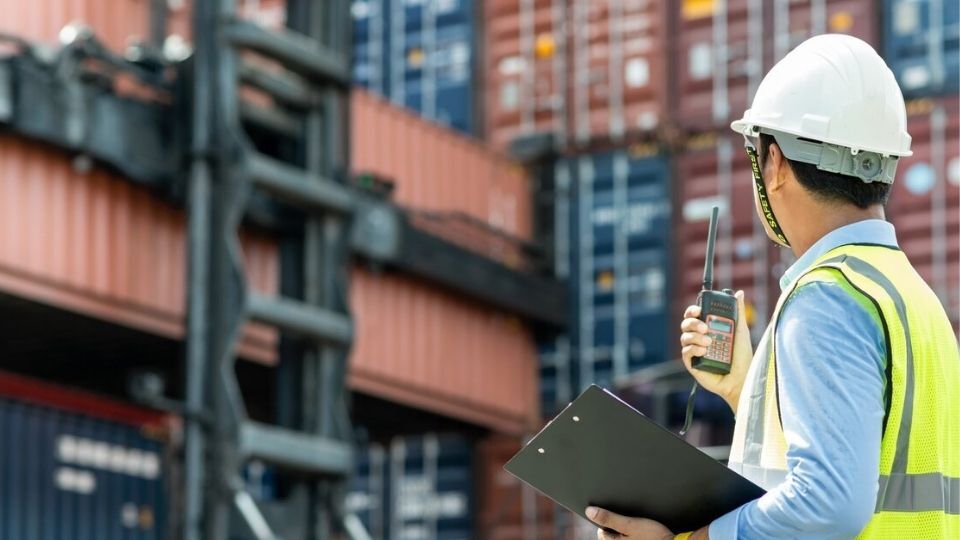
The True Cost of Cargo Theft: When Customer Trust is on the Line
November 24, 2025
2 minute read

Law enforcement technology: Four trends to know for 2026
November 7, 2025
6 minute read

Four seasons of fleet intelligence with Geotab's Public Works solution
November 7, 2025
2 minute read

Infographic: What are the ripple effects of school bus driver turnover?
November 6, 2025
1 minute read

Slash fleet costs: Key strategies for a stronger police budget
October 14, 2025
5 minute read